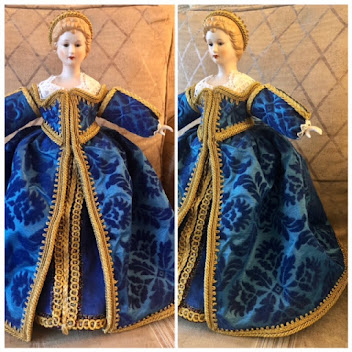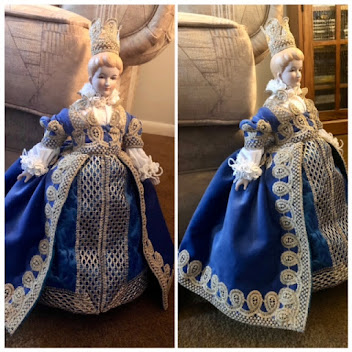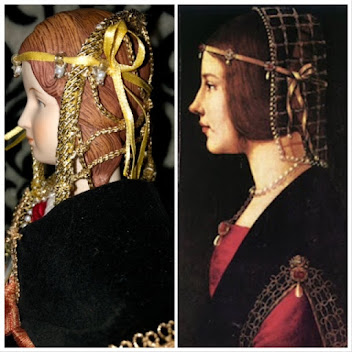I received the embroidered jewelry box in the mail from Ebay. It's lovely embroidery looks to be inspired Jacobean with 3D elements, made in India. There were a few issues with this particular piece. The back panel as you open the box made the lid slide around and was unstable. So I took some matching colored thread and stitch the corners on the back panel to make sure that it was much more secure. Which did really help make sure that you could open and close the box without much trouble and not stress the panel with readjusting of the lid. If this was not fixed it would eventually have the lid ripoff. All these details were disclosed by the seller so I knew what I was getting, new little bit of decorating and some fixing was needed when I purchased.
It's really a pretty piece, larger than in the photo, which is great needing lots of space. I added a few of the berries I made to add some more color, looks nice, not sure if I will add more stumpwork elements or not, guess will see.
I am still creating my personalized embroidered sewing box. Took photos of the crate I am starting with, bought at the thrift shop for a few cents. It looks like it was a display a bath and body works, though any of that will be covered with fabric. I am debating a few period designs, for this project but it's best to draw them out to see if they will work for my intentions for this sewing kit. Brainstorming is my favorite part, making items is fun too but time consuming. Though one doesn't get work done just thinking about it.
Finshing my training at work, packing for my trip to corporate headquarters, lots to do and so little time.
Regards,
Maureen
Subscribe to:
Post Comments (Atom)
Replica 1560's Venetian Italian Fashion Doll

Replica 1560 French Fashion Doll

Tudor Q and A
What is a Tudorosity?
A mashed combination of the words Tudor and Curiosity to create the word Tudorosity. Tudorosities is the plural form and the deffinition is as follows.
Tudorosity- an desire to learn or know anything about the Tudor dynasty associated with years 1405 through 1603.
Most people ask my why I make the Tudor garb ?
I find the clothing of this era not only beautiful but also challenging to sew. There is much more care and purpose put into making garments and wearing garments in the Tudor Era. I love the look of Tudor so much I wanted to explore the way clothes were made back then and the subtle changes in fashion and styles of time.
How did you get started in this interesting hobby?
I started with art first, I love to draw, paint, and sculpt all the traditional fine arts. So being able to draw helps me visualize the looks I want to create in my garb. History has always been a huge interest of mine and I've had a knack for sewing since I was 7 years old. It all started with doll clothes and I learned cross stitch embroidery from my grandmother when I was little. I am self taught sewer, crochet, knitting, embroidery and tatting. My methods are learned from books mainly and there is still so much more to learn.
What is my favorite outfit and why?
It would be like picking a favorite out of one of my future children, its impossible. I love all my gown creations and really like the distinct differences in all the styles clothing I make for the Tudor Era.
Do you make the whole outfit including hat, shoes, and undergarments?
I do have a goal of making a complete Tudor from the skin out. As of right now I make 90% of my gowns and accessories. The shoes and stockings, are bought online and the petticoats are a close reproduction but not made by me. .
How long does it take to make a gown?
It all depends on the type of gown. The making relies on the time period and class of the design. Generally if I work on it 8 hours a day on a sewing machine it will take 3 days to get the basics and another 5 days to do finish hand-sewing details and beading. So a week to a week and a half if working on it steady for that amount of time. I work a full-time job so it does take longer than a week to complete. I put over 40-100 hours per outfit depending on its complexity, its like its own full time job of sorts.
Do you make renaissance clothing for sale or custom orders?
No, due to new employment and changes in my lifestyle. Unfortunately, I have no time to support sewing for others. Though I recommend sewing lessons for those adventurous few. There are many fine folks who make and sell historical clothing. I suggest guidance with sew from many fine historical enthusiastic costumers out on the internet.
How long have you been making these elaborate costumes?
I have been in the Society of Creative Anachronism coming up on my 18th year. Active since 2004 working at demonstrations and volunteering when I could between working and other life's distractions. I really concentrated on Tudor sewing in 2007 and worked with patterns to learn proper fabrics, techniques, fit, and silhouette. I really enjoy the eras transition from a medieval form fitting layered cotterdie to the boned Tudor kirtle and then to structured Elizabethan clothing.
A mashed combination of the words Tudor and Curiosity to create the word Tudorosity. Tudorosities is the plural form and the deffinition is as follows.
Tudorosity- an desire to learn or know anything about the Tudor dynasty associated with years 1405 through 1603.
Most people ask my why I make the Tudor garb ?
I find the clothing of this era not only beautiful but also challenging to sew. There is much more care and purpose put into making garments and wearing garments in the Tudor Era. I love the look of Tudor so much I wanted to explore the way clothes were made back then and the subtle changes in fashion and styles of time.
How did you get started in this interesting hobby?
I started with art first, I love to draw, paint, and sculpt all the traditional fine arts. So being able to draw helps me visualize the looks I want to create in my garb. History has always been a huge interest of mine and I've had a knack for sewing since I was 7 years old. It all started with doll clothes and I learned cross stitch embroidery from my grandmother when I was little. I am self taught sewer, crochet, knitting, embroidery and tatting. My methods are learned from books mainly and there is still so much more to learn.
What is my favorite outfit and why?
It would be like picking a favorite out of one of my future children, its impossible. I love all my gown creations and really like the distinct differences in all the styles clothing I make for the Tudor Era.
Do you make the whole outfit including hat, shoes, and undergarments?
I do have a goal of making a complete Tudor from the skin out. As of right now I make 90% of my gowns and accessories. The shoes and stockings, are bought online and the petticoats are a close reproduction but not made by me. .
How long does it take to make a gown?
It all depends on the type of gown. The making relies on the time period and class of the design. Generally if I work on it 8 hours a day on a sewing machine it will take 3 days to get the basics and another 5 days to do finish hand-sewing details and beading. So a week to a week and a half if working on it steady for that amount of time. I work a full-time job so it does take longer than a week to complete. I put over 40-100 hours per outfit depending on its complexity, its like its own full time job of sorts.
Do you make renaissance clothing for sale or custom orders?
No, due to new employment and changes in my lifestyle. Unfortunately, I have no time to support sewing for others. Though I recommend sewing lessons for those adventurous few. There are many fine folks who make and sell historical clothing. I suggest guidance with sew from many fine historical enthusiastic costumers out on the internet.
How long have you been making these elaborate costumes?
I have been in the Society of Creative Anachronism coming up on my 18th year. Active since 2004 working at demonstrations and volunteering when I could between working and other life's distractions. I really concentrated on Tudor sewing in 2007 and worked with patterns to learn proper fabrics, techniques, fit, and silhouette. I really enjoy the eras transition from a medieval form fitting layered cotterdie to the boned Tudor kirtle and then to structured Elizabethan clothing.
Replica 1490 Milan Italian Fashion Doll

Based on art by Giovanni Ambrogio
O’Kealy Heraldry


No comments:
Post a Comment